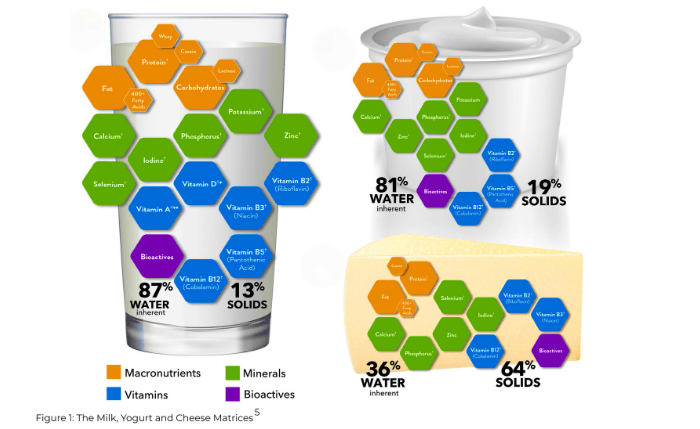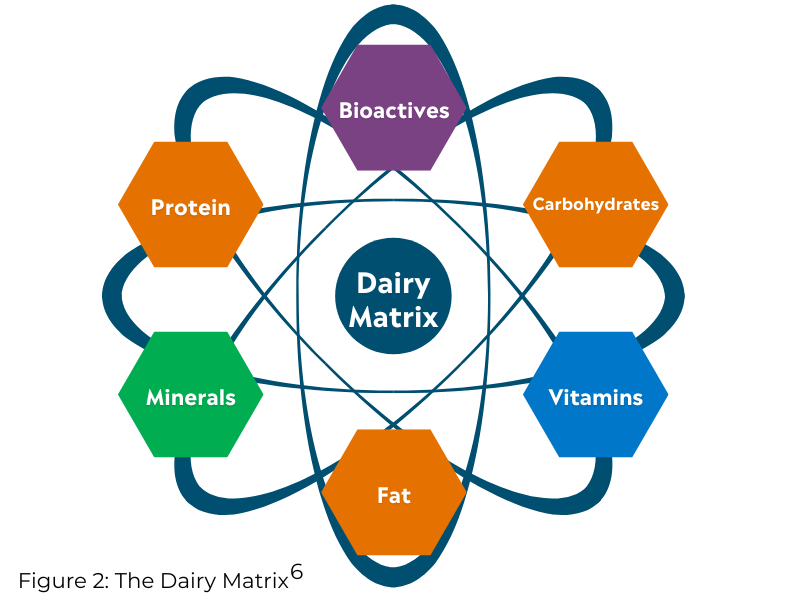
Bessie O’Connor, RDN, of Dairy Council of California contributed an article to the California Academy of Physician Associates member publication that explores how food structure—known as the food matrix—impacts digestion, metabolism, and overall health. This perspective encourages a shift from single-nutrient guidance toward a more holistic, whole-food approach.
Read the full article below to learn how this evolving science supports improved nutrition education and patient care.
California Academy of Physician Associates Publication Article: July-September 2025 Issue
By Bessie O’Connor, RDN, Dairy Council of California
For decades, nutrition guidance has largely focused on
individual nutrients, often cautioning against excessive intake of fat, sodium and sugar, while encouraging underconsumed nutrients such as potassium, fiber, calcium and vitamin D. This nutrient-based approach remains important. However, it's increasingly
clear that health outcomes may depend less on isolated nutrients and more on how those nutrients interact within the structure of foods, also known as food matrices. This advance in nutrition research invites a broader conversation about the role
of food and nutrition in health outcomes.
The food matrix refers to the physical and chemical structure of a food, including how components such as fats, protein, carbohydrates and micronutrients are organized and interact during
digestion and metabolism.1 The food matrix provides a deeper understanding of how food behaves in the body. It encompasses factors like texture, particle size, degree of processing and the presence of bioactive compounds such as polyphenols
in fruits and vegetables or milk fat globule membranes in dairy foods. These structural elements influence how different foods and nutrients are absorbed and metabolized, and ultimately how they impact health.  The dairy food matrix provides a great example of how the interaction of
nutrients and bioactive components within the food structure can influence health outcomes beyond individual nutrients. For instance, despite containing saturated fat and sodium, cheese is associated with reduced risks of mortality and heart disease.2 This
effect is likely explained by the complex interaction of protein, calcium, phosphorus, magnesium and unique microstructures such as milk fat globule membranes within the cheese matrix. Similarly, yogurt consumption is linked to a lower risk of type
2 diabetes, better weight maintenance and improved cardiovascular health.3 Fermented dairy such as yogurt, kefir and some cheese offers a package of probiotics and nutrients in a unique delivery system that slows digestion and supports
gut health, helping to explain its positive impact on disease prevention.
The dairy food matrix provides a great example of how the interaction of
nutrients and bioactive components within the food structure can influence health outcomes beyond individual nutrients. For instance, despite containing saturated fat and sodium, cheese is associated with reduced risks of mortality and heart disease.2 This
effect is likely explained by the complex interaction of protein, calcium, phosphorus, magnesium and unique microstructures such as milk fat globule membranes within the cheese matrix. Similarly, yogurt consumption is linked to a lower risk of type
2 diabetes, better weight maintenance and improved cardiovascular health.3 Fermented dairy such as yogurt, kefir and some cheese offers a package of probiotics and nutrients in a unique delivery system that slows digestion and supports
gut health, helping to explain its positive impact on disease prevention.
For physician assistants, embracing the food matrix concept enhances patient care by supporting more holistic, food-based nutrition counseling. It encourages
moving beyond single-nutrient messages to practical, whole-food guidance that patients can apply. Furthermore, the foods that make up an eating pattern have interactive, synergistic and cumulative relationships that better predict health beyond individual
foods or food groups.4 Milk, yogurt and cheese in the context of balanced dietary patterns that include fruits, vegetables, whole grains, eggs, nuts, seeds, fish and lean meats support evidence-based nutrition guidance.
References:
1. Comerford KB, Unger AL, Cifelli CJ, et al. Decrypting the messages in the matrix: the proceedings of a symposium on dairy food matrix science and public health opportunities. Crit Rev Food Sci Nutr. Published online March 3, 2025. doi:10.1080/10408398.2025.2460606
2. Zhang M, Dong X, Huang Z, et al. Cheese consumption and multiple health outcomes: an umbrella review and updated meta-analysis of prospective studies. Adv Nutr. 2023;14(5):1170-1186. doi:10.1016/j.advnut.2023.06.007
3. Savaiano
DA, Hutkins RW. Yogurt, cultured fermented milk, and health: a systematic review. Nutr Rev. 2021;79(5):599-614. doi:10.1093/nutrit/nuaa013
4. US Department of Agriculture and US Department of Health and Human Services. Dietary Guidelines
for Americans, 2020-2025. 9th Ed. 2020. Accessed June 10, 2025. https://www.dietaryguidelines.gov
5. National Dairy Council. The Dairy Matrix. Accessed
June 11, 2025. https://www.usdairy.com/getmedia/2c7e3fa8-db5b-4b74-b2e6- 1ac750e06d1c/Food-Matrix-More-Than-the-Sum-of-itsNutrients_FINAL.pdf?ext=.pdf
6. Brown K, Hamady C, Cummins S. The Dairy Matrix: More Than the Sum of Its Nutrients [webinar slides]. National Dairy Council; July 15, 2020. Accessed June 11, 2025. https://www.usdairy.com/getmedia/03080c08-4f29-4918-82c0- b2e1e8f97f01/NDC-Dairy-Matrix-Webinar-Slides.pdf